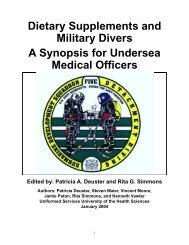Force Health Protection: Nutrition and Exercise Resource Manual
Force Health Protection: Nutrition and Exercise Resource Manual
Force Health Protection: Nutrition and Exercise Resource Manual
You also want an ePaper? Increase the reach of your titles
YUMPU automatically turns print PDFs into web optimized ePapers that Google loves.
In this section two common abdominal exercises, the curl-up <strong>and</strong> the<br />
crunch, will be described. The curl-up, used on the PRT as a measure of<br />
muscle endurance, targets both the abdominal <strong>and</strong> hip flexor muscles. The<br />
form for the curl-up is:<br />
◆ Lie on back with knees bent, feet flat on<br />
deck, heels 10 inches from buttocks <strong>and</strong> held<br />
down by a partner. Cross arms <strong>and</strong> h<strong>and</strong>s on<br />
chest or shoulders.<br />
◆ Curl torso up, touching elbows to upper<br />
thighs while h<strong>and</strong>s remain on the chest or<br />
shoulders. Exhale as you lift.<br />
◆ Lie back until the lower edge of your<br />
shoulder blades touches the deck. Inhale as<br />
you lower.<br />
From OPNAVIST 6110.1E<br />
The crunch is similar to the curl-up but is performed within a smaller<br />
range of motion. The torso is lifted by abdominal muscles during a crunch.<br />
The form for the crunch is:<br />
◆ Lie on back with knees bent 90 o , feet flat on<br />
deck, shoulder width apart. Do not anchor<br />
your feet. (Anchoring your feet or placing<br />
your legs out straight on the deck will target<br />
your hip flexors, not your abdominals.)<br />
◆ Place fingertips lightly on the back of the<br />
head, elbows out to sides <strong>and</strong> in line with<br />
ears. (Variations to this include arms at sides, arms across chest,<br />
<strong>and</strong> arms above head.)<br />
◆ Lift torso until the shoulder blades come off the deck by moving<br />
rib cage toward hips. Exhale as you lift. Look up at the ceiling to<br />
prevent neck strain.<br />
◆ Return to the starting position. Inhale as you lower.<br />
Some people may develop lower back pain if they perform curl-ups<br />
routinely. For them, the crunch is recommended as an alternate exercise.<br />
Regardless of which exercise you choose when training, focus on the quality,<br />
not the quantity, of repetitions. If you perform either exercise rapidly, you<br />
are using momentum <strong>and</strong> not building abdominal strength!<br />
<strong>Nutrition</strong> <strong>and</strong> <strong>Exercise</strong> <strong>Resource</strong> <strong>Manual</strong> 71




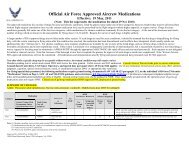
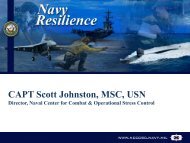
![Body Composition and Military [PDF] - Human Performance ...](https://img.yumpu.com/43269347/1/190x245/body-composition-and-military-pdf-human-performance-.jpg?quality=85)
![Tips for Grocery Shopping [PDF]](https://img.yumpu.com/37447379/1/190x245/tips-for-grocery-shopping-pdf.jpg?quality=85)
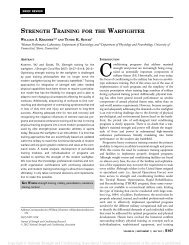
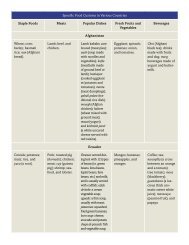
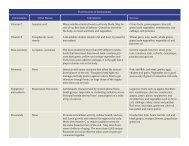
![Synthetic Drugs [PDF] - Human Performance Resource Center](https://img.yumpu.com/37447322/1/190x245/synthetic-drugs-pdf-human-performance-resource-center.jpg?quality=85)
